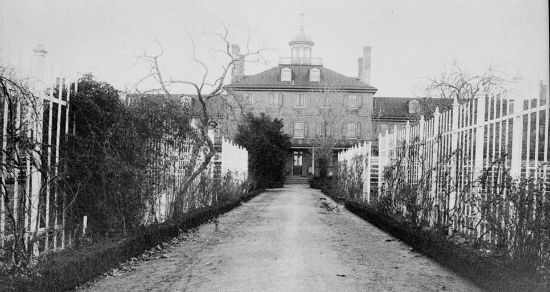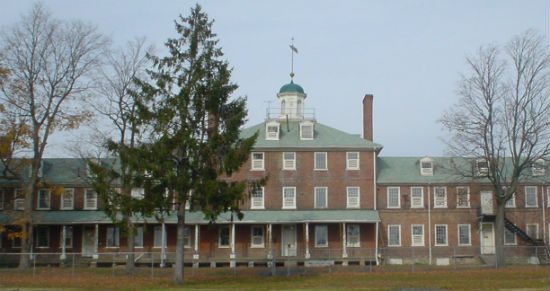We spent the weekend celebrating Maggie’s wedding. She’s a good friend and long-time co-worker of the Slacktivixen (and she looked radiant and, more importantly, deservedly happy).
This wedding took place in Essington, a town probably best known as where you leave your car if you’re flying out of the Philly airport. But it’s also the home of the Lazaretto Ballroom, which was a lovely place for a springtime outdoor ceremony, even if it reminded me a little of Mets games or the U.S. Open at Shea before they tweaked the flight path out of LaGuardia. The ballroom is a nice little facility just South of the airport, tucked in between 291 and the river, on the grounds of an unheralded, largely unknown, and mostly unmarked national historical site.
Here’s a picture of where we were, from 1936. The ballroom now stands where the grand driveway here used to be:

And here’s a more recent photo, from 2009, taken from the other side of the building.

That’s the namesake of the Lazaretto Ballroom, the Philadelphia Lazaretto, founded in 1799 as a quarantine hospital for travelers and immigrants arriving in what was then the nation’s capital. It replaced the previous facility — the Old Lazaretto or “pest house” in the city — after a yellow fever epidemic in the 1790s claimed the lives of about a tenth of Philadelphia’s population. The Lazaretto operated for more than a century, and some guess that as many as a third of all Americans “have an ancestor whose first contact with the New World was at the Lazaretto.”
This seems to me to be an instance where we can and should learn more from the example of America’s “founding fathers” — even if it’s not the sort of thing that the folks who fetishize the founders like to talk about. Contrast the prudence and practicality of establishing this facility with the ugly, irrational panic we saw recently in response to the recent Ebola outbreak in West Africa. The Adams administration didn’t freak out, lose its head, and overreact with talk of closing all the ports and barring all immigration, travel and commerce. Instead, they built a humane facility and set up a new process using the best medical information available at the time.
The term “Lazaretto” for quarantine hospitals, by the way, takes its name from older Christian leper colonies, and thus ultimately from the parable of Lazarus and the rich man in the Gospel of Luke. (That’s one of my favorite Bible stories, partly because it unambiguously presents a soteriology that most defenders of orthodoxy would proclaim to be “unbiblical.”) That captures something of the ethos of such facilities. The sick must be cared for, first of all, because they are sick. Period. But it is also in our self-interest to care for them, because if we fail to do so, there may be Hell to pay.
The Wikipedia entry on the Philadelphia Lazaretto briefly mentions an earlier bit of pertinent American history connected with this site in Essington. “Nearby Province Island,” it says, “was the site of the confinement of the Christian Moravian Indians who were brought there under protective custody from Lancaster, PA in 1763 when their lives were threatened by the Paxton Boys.”
I’m not sure what, exactly, “Province Island” refers to, but from what I can tell it’s no longer around except perhaps as a small piece of land holding up the Platt Bridge or part of I-95. But the Paxton Boys are still with us, at least in spirit. This was a bunch of angry white men riled up by their leader, a clergyman who kept a rifle in his pulpit and warned against phantom threats from the community’s non-white neighbors. They eventually slaughtered dozens of Susquehannock and Conestoga women and children and threatened to bring down the government. (The Pennsylvania government accused them of murder, but they were never arrested nor convicted.) Maybe they remind you of something.
One of the leaders of the Paxton Boys long suspected of orchestrating the murder of their Indian neighbors was a man named Lazarus. Years later, as Captain Lazarus Stewart, he fought in the American Revolution, dying along with his troops in an ill-advised attack on a band of Iroquois warriors. History may not repeat itself, but it often rhymes.
















